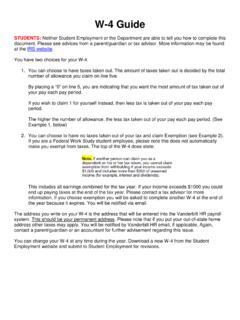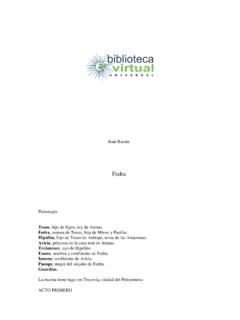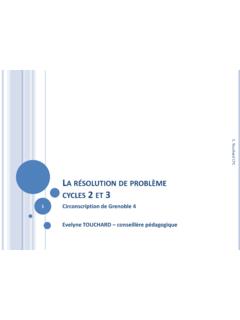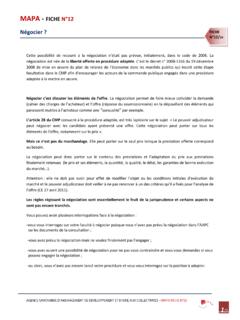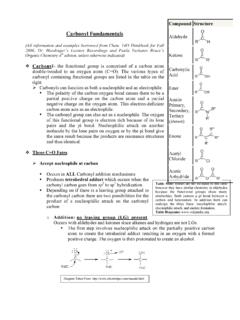Transcription of C-C BOND FORMATION 72 - Vanderbilt University
1 C-C bond FORMATION 72 Carbon- Carbon bond of enolates, enamines and hydrazonesC&S: Chapt. 1, , problems Ch 1: 1; 2; 3, 7; 8a-d; 9; 14 Ch. 2: 1; 2; 4)Smith: Chapt. of heteroatom stabilized anions C&S :Chapt. - ) Smith: Chapt. ReagentsC&S: Chapt. 7, 8, 9 problems ch 7: 1; 2; 3, 6; 13 Ch. 8: 1; 2 Smith: Chapt. Rearrangements . C&S Chapt. , , # 1e,f,h,op Smith Chapt. , Organic Synthesis 1991, vol. 2, -deprotonation of a ketone, aldehyde or ester by treatment with a strong non-nucleophillic carbonyl group stabilizes the resulting negative :ROHH-RO -HH- Base is chosen so as to favor enolate FORMATION .
2 Acidity of C-H bond must be greater(lower pKa value) than that of the conjugate acid of the base (C&S table , pg 3)H3 CCH3 OpKa = 20 MeO- pKa = 15tBuO- pKa = 19unfavorable enolateconcentrationH3 CCH2 OOEtOpKa = 10more favorable enolate concentration- Common bases: NaH, EtONa, tBuOK, NaNH2, LiNiPr2, M N(SiMe3)2,Na CH2S(O)CH3 Enolate FORMATION :- H+ Catalyzed (thermodynamic)OH+OH- Base induced (thermodynamic or kinetic)OH:BO -+B:HRegioselective Enolate FormationTetrahedron 1976, 32, Kinetic enolate- deprotonation of the most accessable proton (relative rates ofdeprotonation).
3 Reaction done under essentially irreversible , THF, -78 CO - Li+C-C bond FORMATION 73typical conditions: strong hindered (non-nucleophilic) base such as LDAR2NH pKa= ~30 NLiEster Enolates- Esters are susceptible to substitution by the base, even LDA can beproblematic. Use very hindered non-nucleophillic base (Li isopropylcyclohexyl amide)ROOR'LDA, THF, -78 CE+RONROOR'THF, -78 CNLiO- Li+OR'R- Thermodynamic Enolate- Reversible deprotonation to give the most stable enolate:more highly substituted C=C of the enol formOtBuO- K+, tBuOHO - K+O - K+kineticthermodynamictypical conditions: RO- M+ in ROH , protic solvent allows reversible enolateformation.
4 Enolate in small concentration (pKa of ROH= 15-18 range)- note: the kinetic and thermodynamic enolate in some cases may be the same- for , -unsaturated ketonesOthermodynamicsitekinetic siteTrapping of Kinetic Enolates- enol acetatesPhO1) NaH, DME2) Ac2 OkineticPhOOPhOO+isolatableseparate & purifyCH3Li, THFCH3Li, THFPhO- Li+PhO- Li+Regiochemicallypure enolatesC-C bond FORMATION 74- silyl enolethersSynthesis 1977, Chem. Res. 1985, 18, ) LDA2) Me3 SiClkineticPhOTMSPhOTMS+isolatablesepara te & purifyCH3Li, THF-or-Bu4NF -or- TiCl4CH3Li, THFPhO- M+PhO- M+Geometricallypure enolates- tetraalkylammonium enolates- "naked" enolates- TMS silyl enol ethers are labile.
5 Can also use Et3Si-, iPr3Si- Silyl enol ether FORMATION with R3 SiCl+ Et3N gives thermodyanamic silyl enol ether- From EnonesO1) Li, NH32) TMS-ClTMSOH1) MeLi2) E+OHEOOSiMe3 OSiMe3 TMS-Cl, Et3 NTMS-OTfEt3 NOOSiMe3Li, NH3, tBuOHTMS-Cl- From conjugate (1,4-) additionsO(CH3)2 CuLiO- Li+E+OETrap or use directly- From reduction of -halo carbonylsOBrZn or MgO- M+Alkylation of Enolates (condensation of enolates with alkyl halides and epoxides)Comprehensive Organic Synthesis 1991, vol. 3, alkyl halides, allylic and benzylic halides work well2 alkyl halides can be troublesome3 alkyl halides don't workC-C bond FORMATION 75Oa) LDA, THF, -78 Cb) MeIOMe- Rate of alkylation is increased in more polar solvents (or addition of additive)(Me2N)3 POHMPARNMe2OR= H DMFR-CH3 DMAH3 CSCH3 ODMSOCH3 NOCH3 NNCH3 OMe2 NNMe2 TMEDAM echanism of Enolate Alkylation: SN2 reaction, inversion of electrophile stereochemistryM+ -OXC180 Alkylation of 4-t-butylcyclohexanone.
6 ORORE equitorial anchorO- M+HtBuREEABHtBuEROAB favoredOREHtBuChairTwist Boaton cyclohexanone enolates, the electrophile approaches from an "axial" trajectory. Thisapproach leads directly into a chair-like product. "Equitorial apprach leads to a higherenergy twist-boat of , -unsaturated carbonylsOR1HR2HO- M+R1R2HO- M+R1HR2 KineticThermodynamicOR1ER2 HOR1HR2 EEEC-C bond FORMATION 76 Stork-Danheiser Enone Transposition:- overall -alkylation of an , -unsaturated ketoneOMeOLDAPhCH2 OCH2 ClOMeOPhOCH3 LiOMeHOPhOCH3 OCH3 PhOH3O+J. Org. Chem. 1995, 60, enolates- Chiral Evans JACS 1982, 104 , 1737; Aldrichimica Acta 1982,15 , Synthesis 1984, 3, N-Acyl oxazolidinonesNOROOMePhMePhH2 NOHnorephedrineNOROOH2 NOHvalinolNOROOMePhNOROOLDA, THFEt-INOROOMePhmajor product (96:4)OHROLiOH, H2O, THFLDA, THFEt-INOROO major product (96:4)OHROLiOH, H2O, THFC omplimentary Methodsfor enantiospecific alkylationsDiastereoselectivity: 92 - 98 %for most alkyl halidesEnolate OxidationChem.
7 Rev. 1992, 92, (SiMe3)2,THF, -78 CNOPhSO2 PhRNOOOOH(88 - 98 % de)LDA, THFOtBuONNOtBuORNOOONBocHNBoc(94 - 98 % de)1) HO-2) CH2N23) TFA4) Raney NiROMeONH2C-C bond FORMATION 77 RNOOOPhBu2 BOTf, Et3 NRNOOOPhBBuBuNBSRNOOOPhBrN3-RNOOOPhN31) LiOH2) H2, Pd/CROHONH2D- amino acidsRNOOOPhKN(SiMe3)2, THFSO2N3 RNOOOPhN3 Oppolzer Camphor based auxillariesTetrahedron, 1987, 43, on the order of 50 : 1 NOOSO2 PhRArNSO2 PhOOArROORSO2N(C6H11)2SO2 NOROOSO2N(C6H11)2Et2Cu BF3 OOSO2N(C6H11)2 HLDA, NBSOOSO2N(C6H11)2 HBrHOOHNH2 Asymmetric Acetate AldolNOOSNH2 OHBrO1)Sn(OTf)2, CH2Cl2, R3N, -40 C2) TIPS-OTf, pyridine3) NH3 BrTIPSO85 %, 19:1 deJ.
8 Am. Chem. Soc. 1998, 120, 591J. Org. Chem. 1986, 51, 2391 Chiral lithium amide basessMeOOMeCO2 EtCH3 PhNOMeLiTHF, -78 C(CH3)2C=OMeOOMeCH3OO(72% ee)C-C bond FORMATION 78tBuO N N NLiPhTHF, HMPATMSCltBuOTMS(97 % ee)ButOHHLiNNPhNMeLewis Acid Mediated Alkylation of Silyl Enolethers- SN1 like alkylationsOTMStBu-Cl, TiCl4,CH2Cl2, -40 C(79%)OCH3C(CH3)3note: alkylation with a 3 alkyl halideOTMSTiCl4, CH2Cl2, -40 C(78%)SPhRClORSPhRaney NiOR(95 %)ACIEE1978, 17, 48TL 1979, 1427 EnaminesGilbert StorkTetrahedron 1982, 38, 1975, Advantages: mono-alkylation, usually gives product from kinetic enolizationNNOO"Kinetic""Thermodynamic"c an not become coplanarONHOH+, (-H2O)NOenamine R-INOR+H2 OOE-Chiral enaminesNEOI mines Isoelectronic with ketonesNOMePhLDA, THF, -20 CNPhMeOLi1) E2) H3O+OEE = -CH3, -Et, Pr, PhCH2-, allyl-ee 87 - 99 %C-C bond FORMATION 79 Hydrazonesisoelectronic with ketonesComprehensive Organic Synthesis 1991, 2, 503OH+, (-H2O)Me2N-NH2 NNLDA, THFNN-NN-E+NNEhydrolysisOE- Hydrazone anions are more reactive than the corresponding ketone or Drawback.
9 Can be difficult to Chiral hydrazones for asymmetric alkylations (RAMP/SAMP hydrazones- D. Enders"Asymmetric Synthesis" vol 3, chapt 4, Academic Press; 1983)NNH2 OMeNH2 NMeOSAMPRAMPNNOMeLDAIOTBSNNOMeTBSOO3 OTBSOH(95 % de)NNOMe1) LDA2) Ts-CH3, THF -95 - -20 C3) MeI, 2N HClOCH3(100 % ee)NR2HR1 NMeOLiZ (C,N)E (C,C)ENR2HR1 NMeOE Aldol CondensationComprehensive Organic Synthesis 1991, 2, 133, ) LDA, THF, -78 Cb R'CHOHORR'OH -hydroxyl aldehyde (aldol)- The effects of the counterion on the reactivity of the enolates can be importantReactivity Li+ < Na+ < K+ < R4N+addition of crown ethersC-C bond FORMATION 80- The aldol reaction is an equilibrium which can be "driven" to 'O- M++RCHOHORR'OMHORR'OHwork-upIn the case of hindered enolates, the equillibrium favors reactants.
10 Mg2+ and Zn2+counterions will stabilize the intermediate -alkoxycarbonyl and push the equillibriumtowards products. (JACS 1973, 95, 3310)O- M+PhCHO, THFOPhOHM= Li 16% yieldM= MgBr 93% yield- Dehydration of the intermediate -alkoxy- or -hydroxy ketone can also serve to drivethe reaction to the Na +, tBuOHOOHOJACS 1979, 101 , 1330 OEnolate Geometry- two possible enolate geometriesOLDA, THF, -78 CO - Li+O - Li++E - enolateZ - enolateHH- enolate geometry plays a major role in (anti)erythro (syn)E-enolateR3 CHO-enolateZR1R2 OMHR2OR1R3 OHR2 OMHR1R1OR2R3 OHR3 CHO- Zimmerman-Traxler Transition State.








